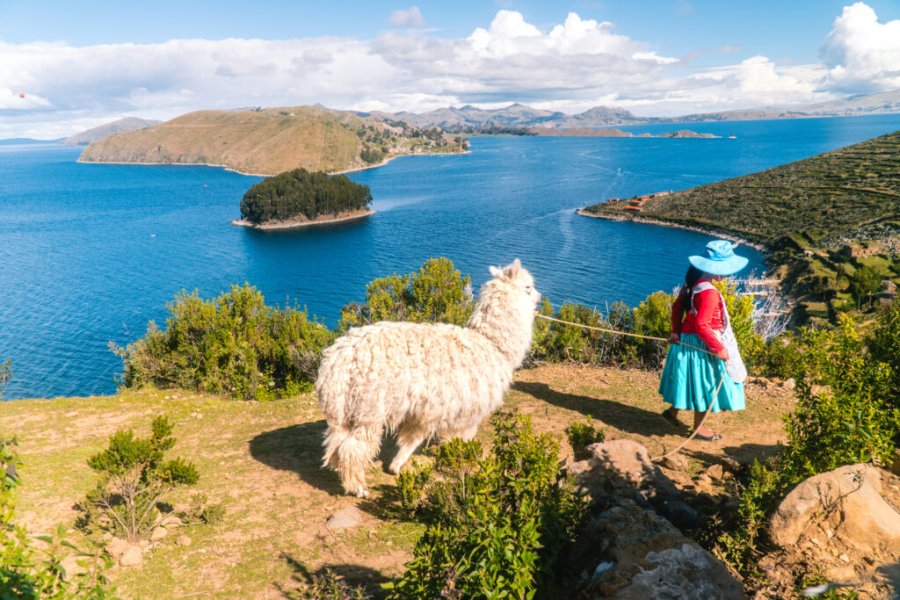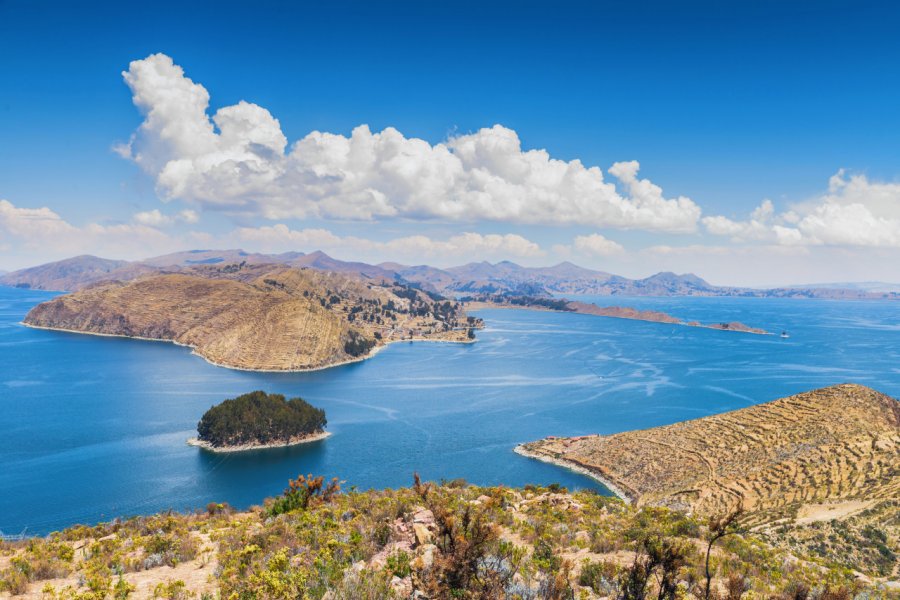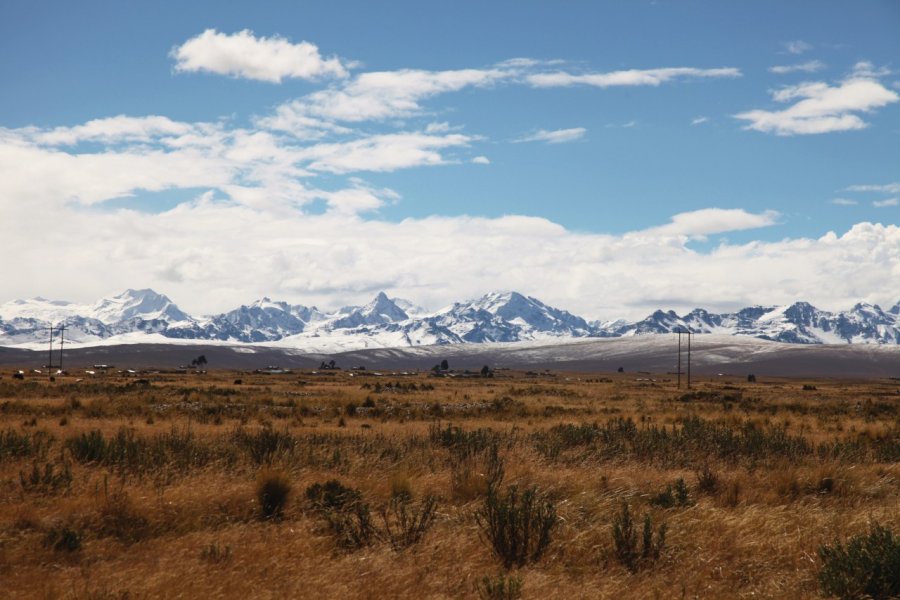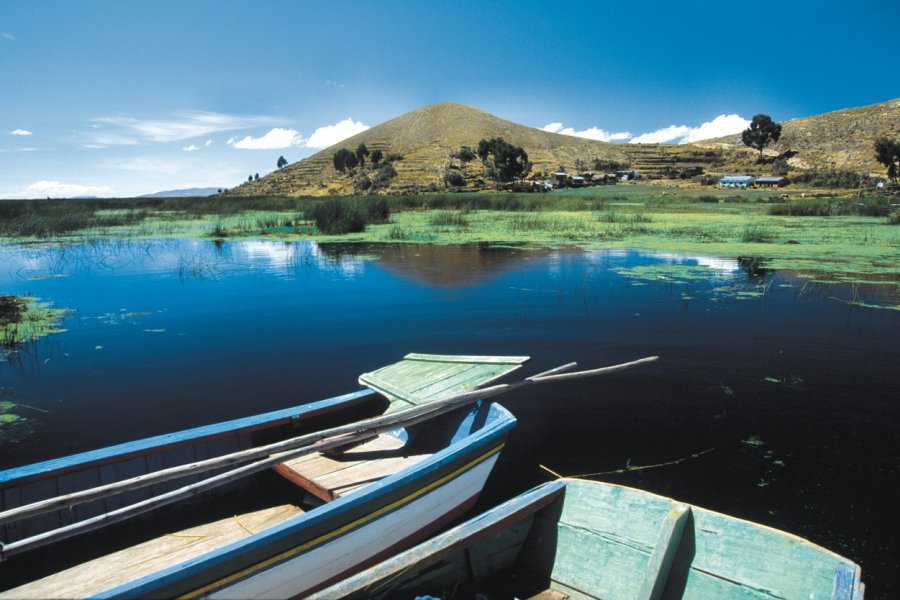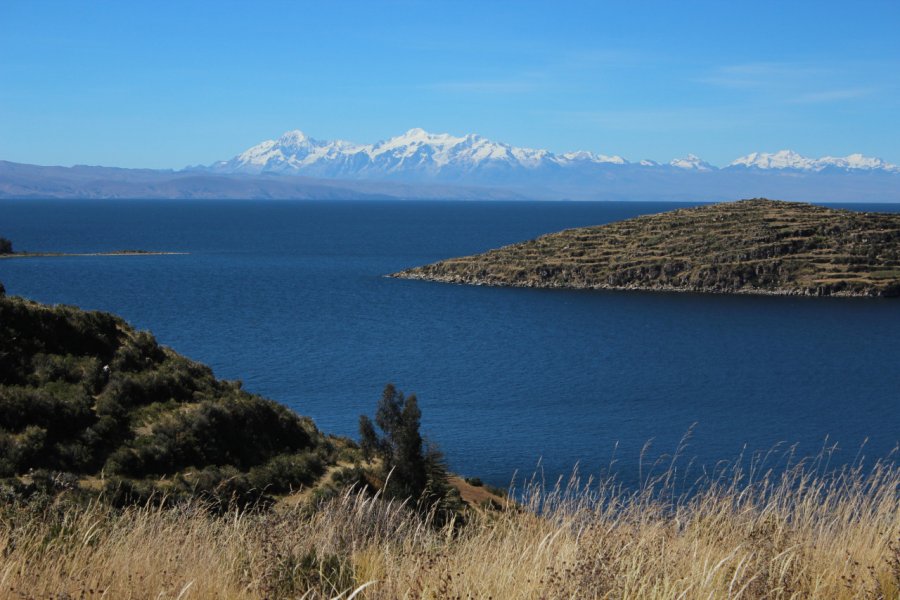Travel Guide Lac Titicaca
Find an accommodation
Advertising
The Titicaca Lake, like Machu Picchu, remains, in our collective unconscious, a name of magic. A fruit of nature and thus the gods for pre-Columbian civilizations, one can easily understand the emotion that hugged the first men in view of this grandiose framework, and the magical-religious genesis that left in. A crossroads of the oldest Amerindian civilizations, the Titicaca Lake has always had a real fascination with travellers and conquerors. From the Tiwanaku Empire to the Catholic clergy, all of them made this jewel one of their religious places. Even today, thousands of pilgrims from all over Bolivia go into procession to gather in front of the Black Virgin of Copacabana at Easter.With the insurmountable barrier of the Royal Cordillera, and its snow-capped peaks over 6 000 metres above sea level, the waters of the lake merge with an intense blue sky, caressed by the colourful sails ballet of fishing vessels. On the island of the Sun, cradle of Inca mythology, there are many vestiges: the temple of Pilkokaina, the Inca temple.The beliefs here are mixed with legends and it is not uncommon to be told one of them by one of the elders of the village of Kalahuta or Tiquira. However, it is necessary to anticipate in the high season or during religious events because the city of Copacabana is being stormed and all the accommodation is complete.History of Sacred Lake" From the cosmic silence of the Sacred Andes Lake, arose from the gods led by the God Wiracocha. He created the first day the sun, the moon, the stars and the gigantic deformed creatures. After many disappointing tests, Wiracocha succeeds in modelling in the mud of the lake, real human beings, and not the uncultivated giants. '»»»»Legend is that the great civilizations of the Altiplano are born in the Titicaca, known as the Sacred Lake. Another legend is that there was a flood in the area occupied by the lake. It was a punishment of the creator God of the world, known as Pachayachachic (invisible lord), because men, by taking over the waters and mountains, had offended him. The God Pachayachachic punishes this affront by launching foudroyants lightning. His anger was so great that he also sent streams of water on the earth. All the men died with the exception of a few, who were innocent. Pachayachachic allowed them to save themselves in the highest trees, then to join mountain peaks to hide in caves. After the flood, the sun began its first radius on the Lake Titicaca.According to another legend, the Sun God had mercy for those who lived as animals. He sent one of his children (Manko Kapak) and one of his daughters (Mama Okllo) to give men knowledge of laws so that they could live as reasonable beings, in houses and in places where they would enjoy the fruits of the earth. The Sun deposited its children on an island (known today as the Island of the Sun) and gave them a gold stick. He ordered them to push this stick in the land wherever they go. At the place where the stick sank and disappeared (today the Cusco region) was founded an empire. Known as Inca Empire, its scope was so large that it occupied what is now Colombia, Ecuador, Peru, Bolivia, northern Argentina and northern Chile.In the past, it was thought that the lake had submerged an entire city. Indeed, a Bolivian explorer, Ramon Avellaneda, and a group of divers found, about eight metres deep, gigantic blocks of stone carved and discovered walls regularly arranged at eight metres below the water level. The myth of a lake atlantis was born. A few years later, Explorer Jacques Cousteau took thirty tons of equipment and two submarines to explore the Titicaca lake. His expedition fell to two hundred metres deep, but did not trace that so-called ancient civilization. The Bolivian archaeologist, Carlos Ponce Sangines, also swore the lake's funds in the search for buried treasures and this mythical city engulfed. If it's true that we've been able to get back to the objects of the lake, from offerings that were made to aquatic deities since the préhispaniques times, we could never bring any evidence to these fantastic stories. Today, we think that these walls are old piers dating back to the late th century. A very simple reason: over the centuries, the level of Lake Titicaca has fallen steadily. How, then, could we have built a city under water? But the so-called city engulfed continues to dream…Origin of lakeFifteen thousand years before the end of the glaciation period, there were two deep inland seas in Altiplano, formed by the accumulation of rainwater, the Altiplano being a closed basin. In the north, including the Titicaca region, was Lake Ballivian. Michin Lake occupied the southwestern part of Bolivia (where there is now the salar of Coipasa and the salar de Uyuni). Fed by the waters of the snow thaw of the mountains and glaciers around them, these two seas were a rich source of water for the Altiplano. During the period of glaciation, the sources were tarirent and, gradually, the two seas were asséchèrent and placed in the Titicaca lake, one of the largest in Latin America. At 3 810 meters above sea level, it holds the title of the highest navigable lake in the world, since in 1872, on the shore a steam raised in the mountain, piece by piece, with mule back.Geographical characteristicsAt an altitude of 3 800 metres, the lake is divided into two almost equal parts between Peru and Bolivia. It is 180 kilometres long and km wide, and consists of two basins (large and minor) separated by a strait. To the east (Bolivian side), the Royal Cordillera and its peaks over 6 000 metres (Illampu, Ancohuma, Condoriri, Huayna Potosí, etc.). In the west, Peru, whose lueurs of coastal cities, is distinguished at night.ClimateThe lake has a permanent microclimate thanks to the significant evaporation of its waters that repousse clouds on the banks and beyond. All year round, it usually makes great weather and the star nights are splendid. It seems that the ozone layer is more fine than normal, we are not talking about a hole in the ozone layer like the one above the Antarctic (not yet…) but particularly careful to protect your eyes and skin in that region.TransportThe arrival at the Lake Titicaca. You can reach Copacabana both by Peru and Bolivia. From La Paz, take four hours of local bus ride. The road runs through the Royal Cordillera and after an hour you reach the first shores of the lake. Then we cross the coastal villages where fishing boats leave, before crossing the Tiquina Strait which separates the major part of the minor part of the lake. Once on the peninsula, take a little less than one hour's drive to Copacabana.From La Paz. Take Manko Kapak minibus or 2 bus to Plaza Tomas Katari, opposite the General Cemetery (ask the taxi driver: el cementerio). Daily departures take place between 7 am and 15 pm. You need to be very careful about your business in this area. Backpack flights have been reported and vigilance is required. Buses leave when they are full and take about 4 hours to reach Copacabana. Most minibuses go to Tiquina. The ticket costs about 15 Bs.Many agencies in La Paz, Calle Sagarnagá, offer tours of one to three days in group, at low prices to Copacabana and Ile du Soleil. These tourist buses cost 30/40 Bs for Copacabana, departures take place around 8 pm from central La Paz hotels.For a different, high-end trip, take restricts from Crillon Tours or Transturin catamarans (see: travel agencies in La Paz).
Suggested addresses Lac Titicaca
Weather at the moment
Advertising
Organize your trip with our partners Lac Titicaca
Transportation
Book your plane tickets
Car Rental
Boat rental
Accommodation & stays
Find a hotel
Holiday rental
Find your campsite
Tailor-made trip
Immersion travel
Services / On site
Activities & visits
Find a doctor
